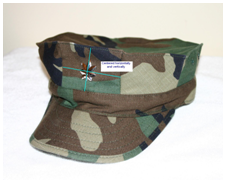Volume 7, No. 9 July 29, 2011
In Brief...
Prior Issues...
- 2008
- 2007
- 2006
- 2005
- 2014
- 2013
- 2012
- 2011
- 2010
- 2009
PDF Archives
- 2000
- 1999
- 1998
- CC Bulletin Supplements
- 2005
- 2004
- 2003
- 2002
- 2001
Hurricane Season
June 1 was the start of Hurricane Season, is your mobility, go-bag ready? http://ccrf.hhs.gov/ccrf/faq_gobag.htm
Below are some helpful reminders for proper Battle Dress Uniform (BDU) wear.
1. If wearing the 8-point Utility Cover, the full size shiny metal rank is worn centered horizontally and vertically on the front panel. If wearing the Captain rank insignia (O-6), the eagle faces the wearer’s right. The stem of the oak leaf points down. Bars are oriented vertically. Stars are oriented with two points of the stars facing down. The Air Force round ‘stove-pipe’ BDU style cover is not authorized. The 8-point Utility Cover is a required basic BDU component. The Command Ball-Cap is an optional item which can be required by mission needs.

2. The PHS Special Unit Identification Patch is required to be worn on the left shoulder ½” inch below the shoulder seam. The “1798” is at the bottom and parallel with the deck (floor).

3. The USPHS name tape does not contain dots/periods between each letter.

4. Skill badges worn above the USPHS name tape are centered above the name tape with a ¼” space between the top of the name tape and the material of the skill badge. Shiny or subdued metal skill badges are not authorized.

5. For routine deployments (in non-tactical environments), the only authorized undershirts are the 100 percent cotton or 50/50 percent polycotton blend black t-shirt with short sleeves and crew neck. The shirt will have a 3 or 4-inch diameter PHS seal (i.e., the “Public Health Service - 1789" seal) printed on the upper, left breast of the shirt. On the back of the shirt vertically centered at about the mid-point of the shoulder blades, in 2-inch high Arial font, “U.S. Public Health Service” will be printed on three lines with “U.S.” on the first line, “Public Health” on the second line, and “Service” on the third line. The PHS Seal and the letters on the back of the undershirt shall be the same yellow as in the yellow quarantine flag when operating under non-tactical conditions. In tactical situations, at the directive of the commander of a Joint Services operation or at the discretion of the LUA, the PHS seal and the lettering on the back of the undershirt will be olive drab or a plain black or olive drab t-shirt may be worn. Other commercial moisture wicking materials or weaves are not authorized for wear with the BDUs.
6. As an option, the olive drab name tape may be sewn above (touching and parallel) the right rear pocket of the BDU trousers.
Q. With promotion season about to kick-off again, what are the rules on frocking and wearing of new rank insignia?
A. First, for those that don’t know what frocking is, it is a custom in which a person (originally monks) wore a vestment or clothing article indicating their change in status. At one time midshipmen (Naval Academy students) wore a short coat, once they were promoted to commissioned officer status or promoted in an acting capacity; they wore the long frocked coat of an officer, hence being “frocked”.
In some uniformed services, it is customary for members who are selected for promotion to a higher rank to wear that rank on their uniform, even though their current actual pay grade/rank is lower, upon being notified of being selected for promotion. This is not universal across the uniformed services nor is it automatically done.
The Corps does not have an official policy on frocking of officers, however the official stance on the matter is that the Corps does not frock, either by wearing the next rank or using the words “Select”, “Rank (Sel)” or any derivation of selected for promotion in the signature block. Officers are reminded that their rank on their uniform must be the same rank on their Uniformed Services of the United States Geneva Conventions Identification Card (military ID card). Gate guards or sentries may deny access to military installations if rank on the uniform and identification card does not match and may also confiscate the identification card. Commissioned Corps Issuance CC26.3.1 Uniforms and Appearance, dated 1 March 2008, Section 6-2c states that officers shall not wear “badges, ribbons, medals or other accoutrements not specifically authorized in accordance with Corps policies, or that have not been annotated in an officer’s electronic Official Personnel Folder (eOPF)” this would include rank insignia.
June 1 was the start of Hurricane Season, is your mobility, go-bag ready? http://ccrf.hhs.gov/ccrf/faq_gobag.htm
Below are some helpful reminders for proper Battle Dress Uniform (BDU) wear.
1. If wearing the 8-point Utility Cover, the full size shiny metal rank is worn centered horizontally and vertically on the front panel. If wearing the Captain rank insignia (O-6), the eagle faces the wearer’s right. The stem of the oak leaf points down. Bars are oriented vertically. Stars are oriented with two points of the stars facing down. The Air Force round ‘stove-pipe’ BDU style cover is not authorized. The 8-point Utility Cover is a required basic BDU component. The Command Ball-Cap is an optional item which can be required by mission needs.

2. The PHS Special Unit Identification Patch is required to be worn on the left shoulder ½” inch below the shoulder seam. The “1798” is at the bottom and parallel with the deck (floor).

3. The USPHS name tape does not contain dots/periods between each letter.

4. Skill badges worn above the USPHS name tape are centered above the name tape with a ¼” space between the top of the name tape and the material of the skill badge. Shiny or subdued metal skill badges are not authorized.

5. For routine deployments (in non-tactical environments), the only authorized undershirts are the 100 percent cotton or 50/50 percent polycotton blend black t-shirt with short sleeves and crew neck. The shirt will have a 3 or 4-inch diameter PHS seal (i.e., the “Public Health Service - 1789" seal) printed on the upper, left breast of the shirt. On the back of the shirt vertically centered at about the mid-point of the shoulder blades, in 2-inch high Arial font, “U.S. Public Health Service” will be printed on three lines with “U.S.” on the first line, “Public Health” on the second line, and “Service” on the third line. The PHS Seal and the letters on the back of the undershirt shall be the same yellow as in the yellow quarantine flag when operating under non-tactical conditions. In tactical situations, at the directive of the commander of a Joint Services operation or at the discretion of the LUA, the PHS seal and the lettering on the back of the undershirt will be olive drab or a plain black or olive drab t-shirt may be worn. Other commercial moisture wicking materials or weaves are not authorized for wear with the BDUs.
6. As an option, the olive drab name tape may be sewn above (touching and parallel) the right rear pocket of the BDU trousers.
Q. With promotion season about to kick-off again, what are the rules on frocking and wearing of new rank insignia?
A. First, for those that don’t know what frocking is, it is a custom in which a person (originally monks) wore a vestment or clothing article indicating their change in status. At one time midshipmen (Naval Academy students) wore a short coat, once they were promoted to commissioned officer status or promoted in an acting capacity; they wore the long frocked coat of an officer, hence being “frocked”.
In some uniformed services, it is customary for members who are selected for promotion to a higher rank to wear that rank on their uniform, even though their current actual pay grade/rank is lower, upon being notified of being selected for promotion. This is not universal across the uniformed services nor is it automatically done.
The Corps does not have an official policy on frocking of officers, however the official stance on the matter is that the Corps does not frock, either by wearing the next rank or using the words “Select”, “Rank (Sel)” or any derivation of selected for promotion in the signature block. Officers are reminded that their rank on their uniform must be the same rank on their Uniformed Services of the United States Geneva Conventions Identification Card (military ID card). Gate guards or sentries may deny access to military installations if rank on the uniform and identification card does not match and may also confiscate the identification card. Commissioned Corps Issuance CC26.3.1 Uniforms and Appearance, dated 1 March 2008, Section 6-2c states that officers shall not wear “badges, ribbons, medals or other accoutrements not specifically authorized in accordance with Corps policies, or that have not been annotated in an officer’s electronic Official Personnel Folder (eOPF)” this would include rank insignia.



